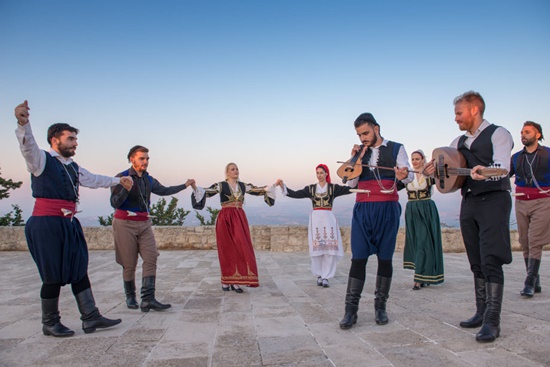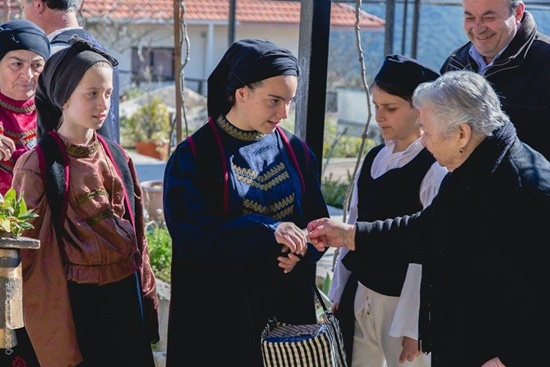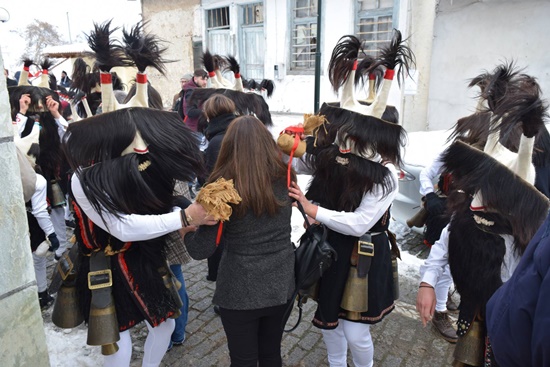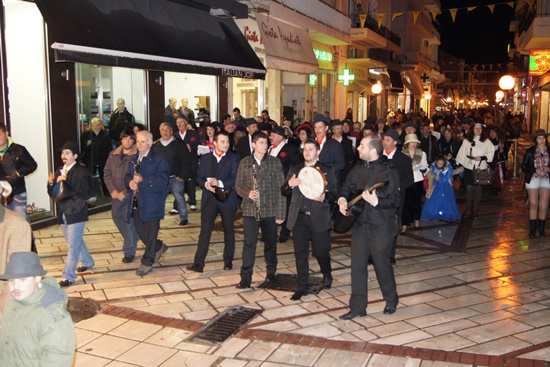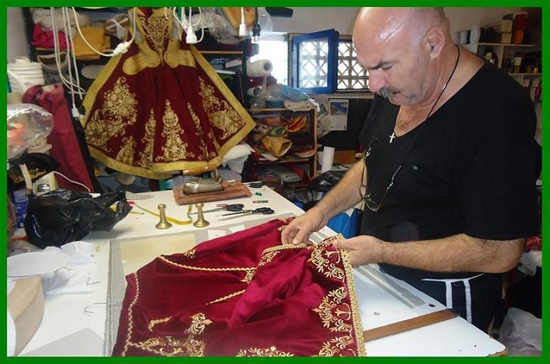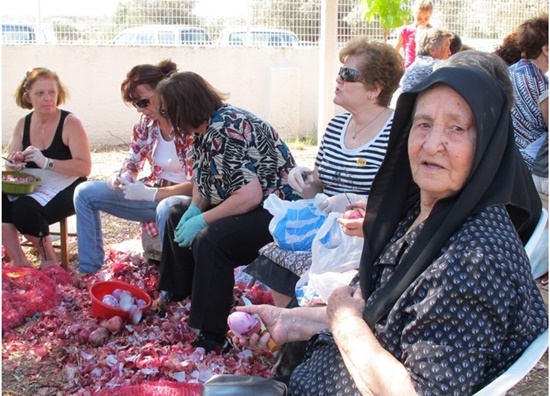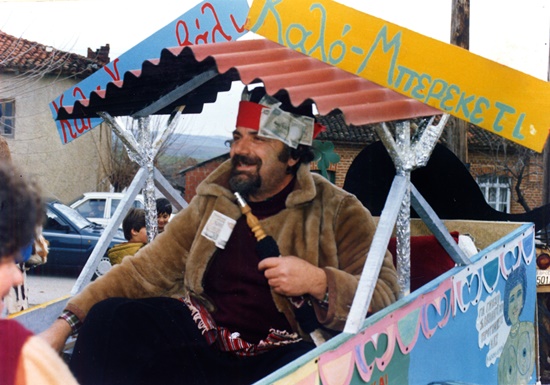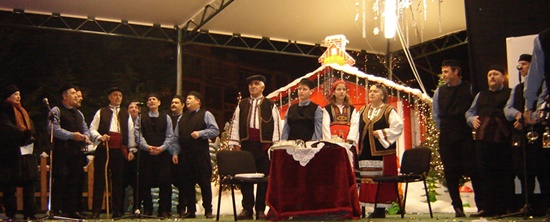The Ministry of Culture announced the registration of 10 new elements in the National Index of Intangible Cultural Heritage
The Syrtos of Crete, the Carnival of Mesotopou Lesbos, the Moiroloi of Panagia in Kopani Dodoni and the Festival of Agios Petros in Spata are among the new entries in the National Index of Intangible Cultural Heritage.
Specifically, the Ministry of Culture announced the registration of ten (10) new items in the National Intangible Cultural Heritage Index.
The ten new elements were systematically studied by the Directorate of Newer Cultural Heritage, the National Scientific Committee for the Application in Greece of the Convention for the Safeguarding of the Intangible Cultural Heritage (UNESCO, 2003) and the communities themselves. The National Scientific Committee gave its opinion on the proposals at the meeting of April 7, 2023. Their proposal was accepted, in its entirety, by the Minister of Culture.
The items registered in the National Index of Intangible Cultural Heritage are the following, according to information from the Ministry of Foreign Affairs:
1. Syrtos, Crete
The syrtos of Crete is a circular dance, based on instrumental melodies with violin or lyre and lute, over which couplets (mandinades) are sung. It is danced mainly by men. Local tradition and research agree that it is located in Western Crete (Kissamos), reinforcing the myth that places the beginnings of the syrto in the 18th century, as the creation of a local musician. During the interwar period it spread throughout Crete. Later, through the movement of Cretan instrumentalists and the dissemination of the discography, it joined the repertoire of dance clubs throughout Greece and the diaspora. The melody of the syrto was recognized internationally, as it was associated with the worldwide “syrtaki” of the movie “Alexis Zorbas”. This specific dance is intertwined with the music and dance tradition and in general the cultural heritage of Crete and especially of Western Crete and the Kissamos region.
2. Mesotopos Lesvos Carnival
The Halloween season has long been celebrated in the Mesotopus of Lesbos with feasts lasting a week. It was an opportunity for the Mesotopians to pay tribute to their tradition, which echoes memories from the Ottoman Empire, Asia Minor and Smyrna. Halloween is a time of revelry for the whole village. The Carnival of Mesotopos, which has been organized since 1987 with the participation of all the institutions of the village, includes carnival events, satire given to local folklore, masked people of all ages, muzzles as they are called, singing, dancing and the so-called koudunatoi, men who walk around in groups in the village, wearing sheep’s bells and having their faces painted black with charcoal and oil. The Mesotopou Lesvos Carnival is an important element of the community’s collective memory and identity, but also a popular carnival event that excites the general public.
3. Maleviziotis
Maleviziotis is a Cretan dance, circular and lively. It is danced by men and women with clasped hands, in 2/4 time, accompanied by lyre or violin, lute, mandolin or ascomandura. It is a dance of great dynamics and intensity, lively and impressive, which allows the dancers, especially the first dancer, to improvise and demonstrate his skill.
It is connected to the music and dance tradition, the cultural identity and all aspects of the social life of the Cretans and especially the Maleviziotes, because it took its final form in the province of Malevizio, in the prefecture of Heraklion. Today, it is danced all over Greece and among the Greek diaspora, as it has spread widely through the learning of Cretan dances, mainly in the context of dance clubs.
4. The Moiroloi of Panagia, in Kopani Dodoni
They are Easter carols that are sung every Good Friday in many regions of Greece, including in Kopani Dodoni. The carols narrate the lamentation of the Virgin Mary for her only son. The members of the Kopani community, the majority of whom no longer live permanently in the village, have the opportunity to meet and renew their common bonds, participating in the custom that keeps alive the tradition of their ancestors. The Fate of the Virgin has been revived in Kopani since 2006, representing an important manifestation of the collective memory of the community.
5. Babougera, in the Good Fountain of Drama
The event takes place in the Kali Vrysi of Drama, on January 6-7 and 8, every year. Members of the community, in animal-like disguises, with bells belted around their waists and with masks on their heads, move around the village singing and dancing. The climax of the action is on January 8 with the representation of a satirical wedding. It is an important element of collective memory and identity of the community of Kali Vrysis Drama.
6. Artas Bandits and Carousel (traditional Halloween events)
Customary carnival events held in the city of Arta, with the main features being disguises, skating accompanied by traditional scales and stops at designated points, where orchestral episodes are performed with playful couplets, with circle carnival dances.
Bandidos are groups of ten to fifteen men, who on Thursday and Friday, before the Great Halloween, start from the neighborhoods of Arta singing and teasing the people. They end up in the central streets of the city, satirizing current events, people and situations. On Shrovetide Saturday, the participants, wearing masks and dressed either as janissaries or as brides, take to the main streets of the city and the neighborhoods. Every now and then they stop and weave the merry-go-round, a piece of wood on the top of which twelve ribbons are tied and hung, as many as the months of the year, sometimes with drag dances, sometimes with chamika (a special melody called Gaitanaki) and at the end with the chants of the violinists. After the knitting, carnival activities and dances follow. The custom is an important expression of the collective memory and identity of the city of Arta and the people of Artina everywhere.
7. The art of making replicas of traditional clothing, as practiced by Nikolaos Plakidas, in the Occupation of Etoloakarnania
Nikolaos Plakidas sews and embroiders faithful copies of traditional costumes. The costumes are created to order, in order to be worn at weddings, festivals, reenactments of historical events, parades, etc. The workshop of Nikolaos Plakidas is located in the Municipality of the Holy City of Messolonghi, in the Prefecture of Etoloakarnania, in the Region of Western Greece, an area where many celebrations and festivals take place , such as the feast of the Exodus in Messolongi, the feasts of Agia Agatha in Aitoliko, Ai-Symios in Messolongi, Agia Paraskevi in Neochori. The art of making copies of traditional clothing, as practiced by Nikolaos Plakidas, in the Occupation of Etoloakarnania, is an example of adaptation to the modern cultural environment of the art of the Greek tailor.
8. The festival of Agios Petros in Spata
It takes place during the three-day celebration of Saints Peter and Paul, in Spata, on June 29, combining elements of the official Christian religion and popular worship. During the celebration, animals (bulls) are offered as tamas, whose meat is made into a stew. The preparation of the food requires the cooperation of all the inhabitants of the village, who contribute voluntarily, as a fulfillment of the diet for health and a good harvest. In recent years the community, respecting the parameters that now govern the behavior of people towards animals, does not perform the bull sacrifice. The festival of Agios Petros in Spata is a customary practice that contributes to the preservation of the collective memory and identity of the residents of Spata and strengthens the ties that bind the people of Spata everywhere to their place.
9. “Beis” Protoklisiou
“Beis” is a Halloween event with a playful – mocking character that is carried out by men on Clean Monday, in the refugee village of Protokklisi in the municipality of Soufli, in Evros. Young and older people participate, forming a troupe and wandering around the village dancing to the sounds of bagpipes and drums. “Beys” is an important expression of the collective memory and identity of the community of Protoklisio of the municipality of Soufli Evros.
10. Cold water carol of Eastern Thrace, in Kalamaki, Drama
These are carols of religious content that are sung antiphonally, in Kalamaki, Drama, on the night of Christmas Eve until dawn, by groups of single young men, with which the carolers announce the joyful news of the birth of Christ. The carols are accompanied by songs for the host and his family. The carols are an important manifestation of the collective memory of the Kalambaki community of Drama, especially the descendants of refugees from Kryonero in Eastern Thrace.
Source :Skai
I am Frederick Tuttle, who works in 247 News Agency as an author and mostly cover entertainment news. I have worked in this industry for 10 years and have gained a lot of experience. I am a very hard worker and always strive to get the best out of my work. I am also very passionate about my work and always try to keep up with the latest news and trends.


